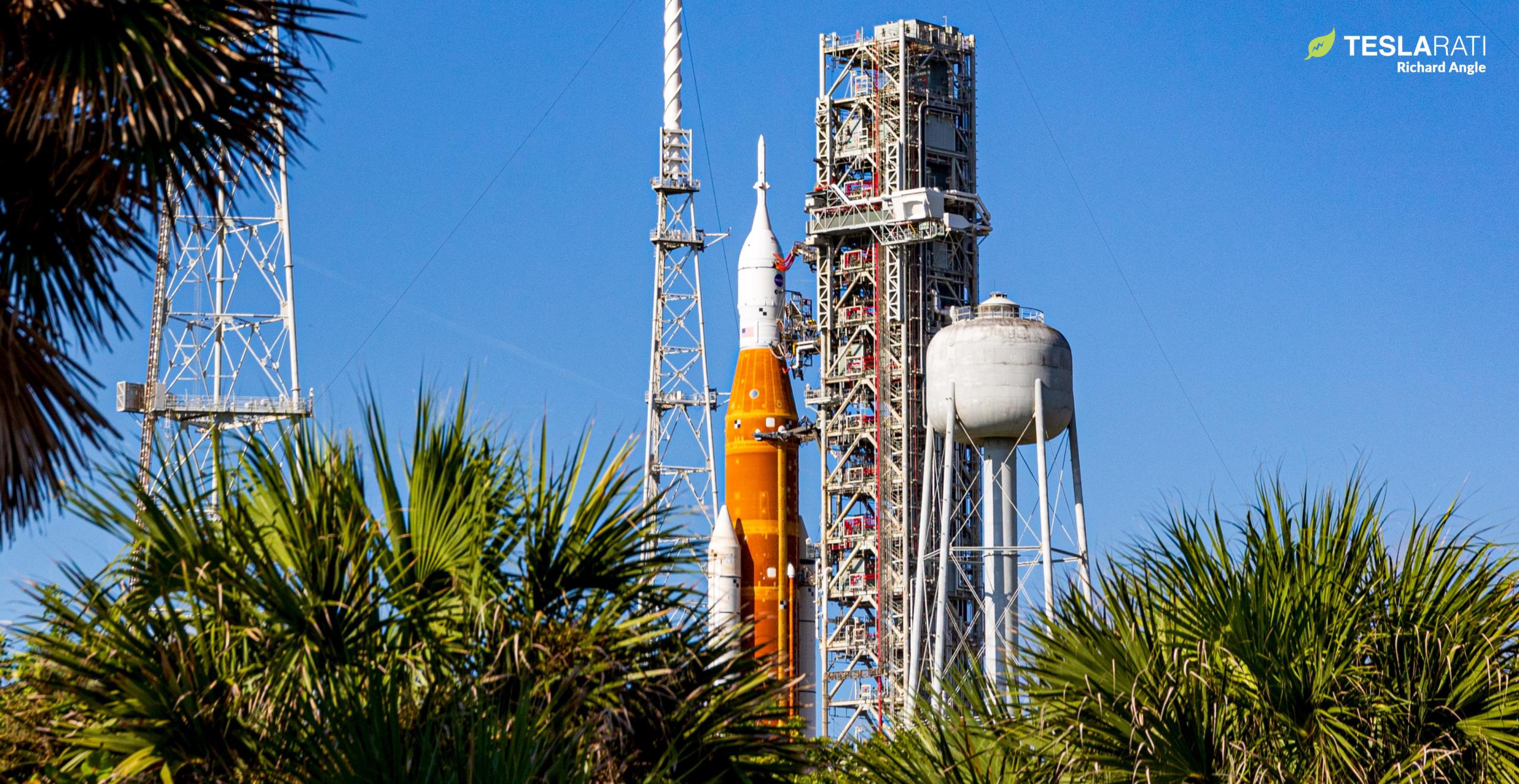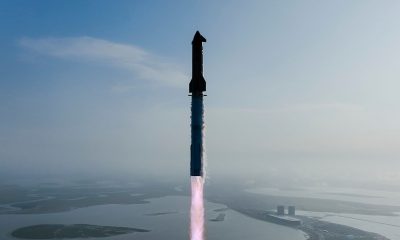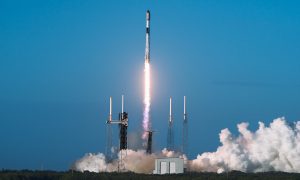

News
NASA’s SLS Moon rocket almost aces vital prelaunch test on 7th try
Following several incomplete attempts in April, June, August, and September, NASA’s first Space Launch System (SLS) Moon rocket has almost aced a vital prelaunch test on the seventh try.
NASA says that “all objectives were met” during the ten-hour test, which wrapped up around 4:30 pm EDT (20:30 UTC) on Wednesday, September 21st. Despite the rocket running into multiple additional issues, some old and others new, the agency was confident enough in the preliminary results of the wet dress rehearsal (WDR) – deemed a “cryogenic demonstration test” – to reaffirm that it’s still working towards a third launch attempt as early as September 27th.
That launch date is not set in stone, but NASA also hasn’t ruled out the window after the latest round of SLS testing. The agency will host a press conference on Friday, September 23rd, to provide its final decision and offer more details about the seventh wet dress rehearsal.
Despite NASA’s apparent confidence after the test, which was admittedly smoother than most previous SLS tests at the launch pad, it was far from smooth. The immediate story of the “cryogenic demonstration test” dates back to the SLS Artemis I rocket’s second so-called “launch attempt” on September 3rd. During that attempt, the launch was aborted well before SLS was ready when NASA detected a major hydrogen fuel leak around one of the quick-disconnect umbilical panels that fuels and drains the rocket. Remote troubleshooting was unable to solve the problem, forcing NASA to stand down.
Over the last few weeks, teams inspected, tested, and repaired the faulty Tail Service Mast Umbilical (TSMU), preparing for a cryogenic proof test meant to verify that the issue was fixed. During that September 21st test, the TSMU still leaked significantly for the whole duration, but it did so more predictably and – unlike prior leaks – never violated the limits that would trigger a launch abort.
But near the end, a different umbilical panel developed a significant hydrogen leak that did violate those launch constraints, meaning that NASA would have likely had to stand down yet again if it had attempted to launch before completing additional testing. The test was completed successfully, but its goals and constraints were not the same as those facing a launch.
A NASA-developed rocket leaking hydrogen is unfortunately a tale as old as time. That the agency that struggled with hydrogen leaks throughout the 30-year career of the Space Shuttle appears to be just as flabbergasted by nearly identical problems on a new rocket – SLS – that has Shuttle ‘heritage’ on almost every square inch is not surprising, even if it is somewhat embarassing.
Liquid hydrogen fuel always has been and likely always will be a massive pain to manage in any rocket, but especially in a large rocket. As the smallest element in the universe, it is fundamentally leak-prone. Combined with the fact that it only remains liquid below the extraordinarily low temperature of -253°C (-423°F), generates ultra-flammable hydrogen gas as it continually attempts to warm to a more stable temperature, and naturally embrittles most metals, it’s an engineering nightmare by almost every measure.
For all that pain, hydrogen does provide rocket engineers exceptional efficiency when properly exploited, but even that positive aspect is often diminished by hydrogen’s ultra-low density. For rocket stages that have already reached orbit, hydrogen-oxygen propellant offers unbeatable efficiency. But for a rocket stage that will never be used in orbit, like the SLS core stage, hydrogen fuel is rarely worth the tradeoffs – a reality that SLS is unfortunately providing a strong reminder of.
Demonstrating the Groundhog Day-esque nature of NASA rockets and hydrogen leaks, the same leaky TSMU panel that aborted SLS’ September 3rd launch attempt (sixth WDR) and had to be fixed and retested on September 21st also caused a hydrogen leak that partially aborted the rocket’s third wet dress rehearsal attempt in April 2022. NASA then rolled the rocket back to the Vehicle Assembly Building (VAB), where workers spent almost two months inspecting and reworking the fuel TSMU and fixing other issues. During its first test (WDR #4) after rolling back to the pad in June, the same fuel TSMU leaked and NASA had to return the rocket to the VAB again to fix the problem.
The fuel TSMU then leaked on the SLS rocket’s first launch attempt (really WDR #5), but the problem was resolved and was not what caused NASA to stand down. It was, however, a primary reason behind NASA’s second aborted launch attempt (WDR #6). With any luck, the eighth time will be the charm.
News
Tesla begins Robotaxi certification push in Arizona: report
Tesla seems serious about expanding its Robotaxi service to several states in the coming months.

Tesla has initiated discussions with Arizona transportation regulators to certify its driverless Robotaxi service in the state, as per a recent report from Bloomberg News. The move follows Tesla’s launch of its Robotaxi pilot program in Austin, Texas, as well as CEO Elon Musk’s recent comments about the service’s expansion in the Bay Area.
The Arizona Department of Transportation confirmed to Bloomberg that Tesla has reached out to begin the certification process for autonomous ride-sharing operations in the state. While details remain limited, the outreach suggests that Tesla is serious about expanding its driverless Robotaxi service to several territories in the coming months.
The Arizona development comes as Tesla prepares to expand its service area in Austin this weekend, as per CEO Elon Musk in a post on X. Musk also stated that Tesla is targeting the San Francisco Bay Area as its next major market, with a potential launch “in a month or two,” pending regulatory approvals.
Tesla first launched its autonomous ride-hailing program on June 22 in Austin with a small fleet of Model Y vehicles, accompanied by a Tesla employee in the passenger seat to monitor safety. While still classified as a test, Musk has said the program will expand to about 1,000 vehicles in the coming months. Tesla will later upgrade its Robotaxi fleet with the Cyercab, a two-seater that is designed without a steering wheel.
Sightings of Cybercab castings around the Giga Texas complex suggests that Tesla may be ramping the initial trial production of the self-driving two-seater. Tesla, for its part, has noted in the past that volume production of the Cybercab is expected to start sometime next year.
In California, Tesla has already applied for a transportation charter-party carrier permit from the state’s Public Utilities Commission. The company is reportedly taking a phased approach to operating in California, with the Robotaxi service starting with pre-arranged rides for employees in vehicles with safety drivers.
News
Tesla sets November 6 date for 2025 Annual Shareholder Meeting
The automaker announced the date on Thursday in a Form 8-K.

Tesla has scheduled its 2025 annual shareholder meeting for November 6, addressing investor concerns that the company was nearing a legal deadline to hold the event.
The automaker announced the date on Thursday in a Form 8-K submitted to the United States Securities and Exchange Commission (SEC). The company also listed a new proposal submission deadline of July 31 for items to be included in the proxy statement.
Tesla’s announcement followed calls from a group of 27 shareholders, including the leaders of large public pension funds, which urged Tesla’s board to formally set the meeting date, as noted in a report from The Wall Street Journal.
The group noted that under Texas law, where Tesla is now incorporated, companies must hold annual meetings within 13 months of the last one if requested by shareholders. Tesla’s previous annual shareholder meeting was held on June 13, 2024, which placed the July 13 deadline in focus.
Tesla originally stated in its 2024 annual report that it would file its proxy statement by the end of April. However, an amended filing on April 30 indicated that the Board of Directors had not yet finalized a meeting date, at least at the time.
The April filing also confirmed that Tesla’s board had formed a special committee to evaluate certain matters related to CEO Elon Musk’s compensation plan. Musk’s CEO performance award remains at the center of a lengthy legal dispute in Delaware, Tesla’s former state of incorporation.
Due to the aftermath of Musk’s legal dispute about his compensation plan in Delaware, he has not been paid for his work at Tesla for several years. Musk, for his part, has noted that he is more concerned about his voting stake in Tesla than his actual salary.
At last year’s annual meeting, TSLA shareholders voted to reapprove Elon Musk’s compensation plan and ratified Tesla’s decision to relocate its legal domicile from Delaware to Texas.
Elon Musk
Grok coming to Tesla vehicles next week “at the latest:” Elon Musk
Grok’s rollout to Tesla vehicles is expected to begin next week at the latest.

Elon Musk announced on Thursday that Grok, the large language model developed by his startup xAI, will soon be available in Tesla vehicles. Grok’s rollout to Tesla vehicles is expected to begin next week at the latest, further deepening the ties between the two Elon Musk-led companies.
Tesla–xAI synergy
Musk confirmed the news on X shortly after livestreaming the release of Grok 4, xAI’s latest large language model. “Grok is coming to Tesla vehicles very soon. Next week at the latest,” Musk wrote in a post on social media platform X.
During the livestream, Musk and several members of the xAI team highlighted several upgrades to Grok 4’s voice capabilities and performance metrics, positioning the LLM as competitive with top-tier models from OpenAI and Google.
The in-vehicle integration of Grok marks a new chapter in Tesla’s AI development. While Tesla has long relied on in-house systems for autonomous driving and energy optimization, Grok’s integration would introduce conversational AI directly into its vehicles’ user experience. This integration could potentially improve customer interaction inside Tesla vehicles.
xAI and Tesla’s collaborative footprint
Grok’s upcoming rollout to Tesla vehicles adds to a growing business relationship between Tesla and xAI. Earlier this year, Tesla disclosed that it generated $198.3 million in revenue from commercial, consulting, and support agreements with xAI, as noted in a report from Bloomberg News. A large portion of that amount, however, came from the sale of Megapack energy storage systems to the artificial intelligence startup.
In July 2023, Musk polled X users about whether Tesla should invest $5 billion in xAI. While no formal investment has been made so far, 68% of poll participants voted yes, and Musk has since stated that the idea would be discussed with Tesla’s board.
-

 Elon Musk1 week ago
Elon Musk1 week agoTesla investors will be shocked by Jim Cramer’s latest assessment
-

 Elon Musk3 days ago
Elon Musk3 days agoElon Musk confirms Grok 4 launch on July 9 with livestream event
-

 Elon Musk15 hours ago
Elon Musk15 hours agoxAI launches Grok 4 with new $300/month SuperGrok Heavy subscription
-

 News7 days ago
News7 days agoTesla Model 3 ranks as the safest new car in Europe for 2025, per Euro NCAP tests
-

 Elon Musk2 weeks ago
Elon Musk2 weeks agoA Tesla just delivered itself to a customer autonomously, Elon Musk confirms
-

 Elon Musk1 week ago
Elon Musk1 week agoxAI’s Memphis data center receives air permit despite community criticism
-

 Elon Musk2 weeks ago
Elon Musk2 weeks agoTesla’s Omead Afshar, known as Elon Musk’s right-hand man, leaves company: reports
-

 News2 weeks ago
News2 weeks agoXiaomi CEO congratulates Tesla on first FSD delivery: “We have to continue learning!”

















